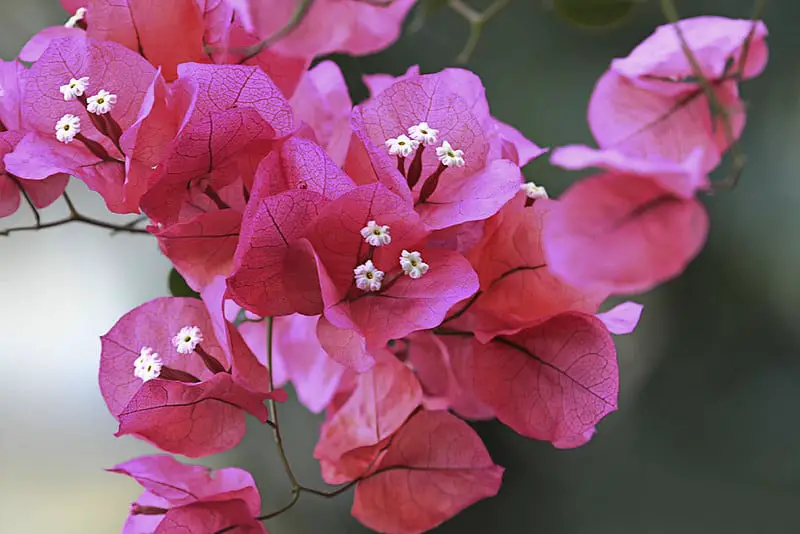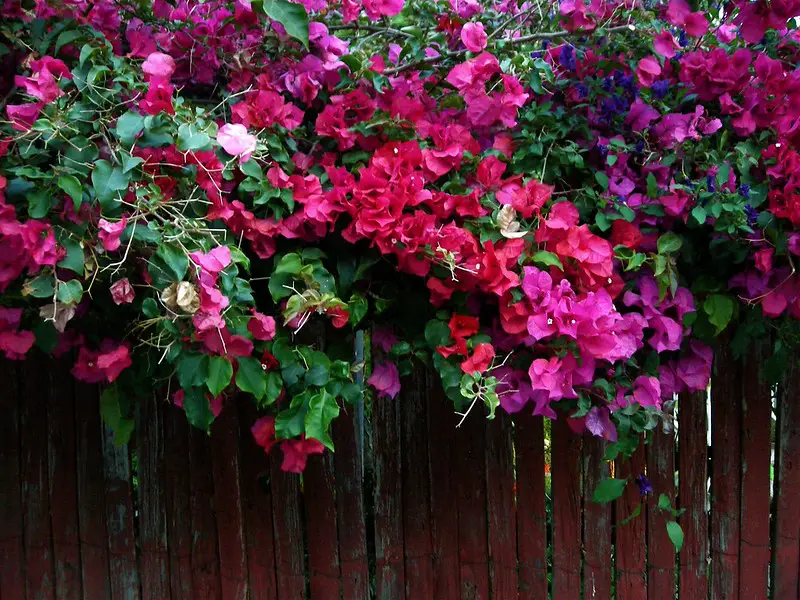If you’re looking for a showy plant that will bring a punch of color and tropical touch to your garden, then a gorgeous Bougainvillea is the best choice. These colorful ornamental shrubs, vines, and trees truly make a wonderful display. Read on to learn how to grow and care for Bougainvillea.

What Kind of Plant is Bougainvillea?
The Bougainvillea genus consists of 18 species of trees, shrubs, and vines native to South America. However, bougainvilleas are globally cultivated, mostly because of the colorful explosion they put out.
Their vibrant color actually doesn’t come from their flowers. Colorful, profuse bracts are responsible for the bougainvillea’s stunning appearance, while the flowers are tiny and white. Each flower is surrounded by the clusters of papery bracts that come in a wide range of bright colors: red, purple, fuchsia, magenta, orange, white, burgundy, or yellow.
Bougainvilleas can grow from 1 to 12 m (3 to 40 ft) tall, although there are many dwarf varieties such as B. glabra. They are rapid growers – they can grow more than 36 inches (90 cm) per year.
Their versatile growth habit really gives plenty of possibilities for landscaping and ornamental planting. They can be grown as a single-stem tree with a compact, round look, or trained as vines. You can prune them into a bush, or make a hedge out of them. They are also suitable for growing in containers or hanging baskets, and they can be grown indoors in cooler climates as well.
It’s important to remember that bougainvilleas don’t attach itself like jasmine or trumpet vine. Instead, they have to be trained and manually attached.
Growing Conditions for Bougainvillea
Since these vigorous growers are native to tropical and subtropical regions of South America, they prefer a warm climate and lots of sun. The more sun you provide them, the more bracts plants produce. They can tolerate afternoon shade, but if you have to choose between full-sun and partial shade, always go for the first.
More warmth and more sun equals more color and blooms for a bougainvillea.
As perennials, they can be grown outdoors in USDA Hardiness zones 9-11. In these USDA zones, so as any warm-climate region, these beauties will produce vibrant bracts throughout the entire year.
How to Care for Bougainvillea
Bougainvilleas are fairly easy to grow and pretty hardy once they establish the root system. Follow these simple steps to keep them healthy:
- Light Requirements: Provide them with at least 6 hours of sun per day, and leave rest to them.
- Soil and Fertilizing: They can withstand any type of soil as long as it drains well. You can go for the soil mixture similar in their native surroundings – the mix of loam and organic compost.
- Fertilize Requirements: You can fertilize a bougainvillea twice a year – once in the early spring and again in mid-summer. Choose a slow-release, all-purpose fertilizer that moderates the release of nitrogen. Nitrogen is responsible for vegetative growth, which means more leaves and fewer flowers.
- Water Requirements: As many tropical plants, bougainvillea doesn’t like wet feet, so good drainage and careful watering are mandatory. They are used to drought and prefer dry conditions. Bougainvilleas can go without rain for several months.
- Pests and Diseases: You will face minimal pest-related problems with bougainvilleas. They may be susceptible to worms, snails, and aphids, but infestations are rare. If any of these problems occur, treat the problem immediately using an adequate pesticide.

How to Care for Bougainvillea in Winter
If you’re lucky enough to live in climate region with mild winter, then you’ll enjoy bougainvillea’s blooms year-round.
In cooler climates where winter gets rough, bougainvilleas can be grown as annuals if you cut them back and move indoors during the cold months. Since they prefer cooler spots indoors with the optimal temperature around 8-10 C (46-50 F), the ideal place for them is a garage or covered porch.
During this period, don’t expect your bougainvillea to grow or produce flowers – it will survive the winter in dormancy. move it outdoors when all danger of frost is over.
How to Prune and Trim Bougainvillea
The pruning method for bougainvilleas depends on the variety you choose and the shape you wanna set. If you’d like a more compact shape, you will trim any branches outside your framework. If you prefer vines, you will let the bougainvillea grow naturally.
However, everyone’s surely wondering if there’s a way to prune a bougainvillea for maximum bloom?
The answer is yes – you can prune bougainvillea to get more blooms.
You will need to perform several prunings during the year. The first one should be done in late winter and should establish the shape you wanna get.
As the season progresses, you will need to prune a bougainvillea after every blooming cycle. Bougainvilleas produce blooms on new growth, so you will have to encourage the new growth by regular trimming. You can completely cut back old growth that is damaged or seems excess. Remove any branches that are blocking good air circulation to prevent pest infestation.
New-grown, long branches should be pruned back by the half (just above the bud), while shorter ones can be tip-pruned. This will encourage new growth and make your bougainvillea more dense and compact.
Removing any unnecessary shots and side branches will help the plant to focus its energy to produce more blooms.
Although this kind of pruning may seem too harsh, don’t worry – bougainvilleas grow quite fast and they need regular pruning to produce maximum blooms.